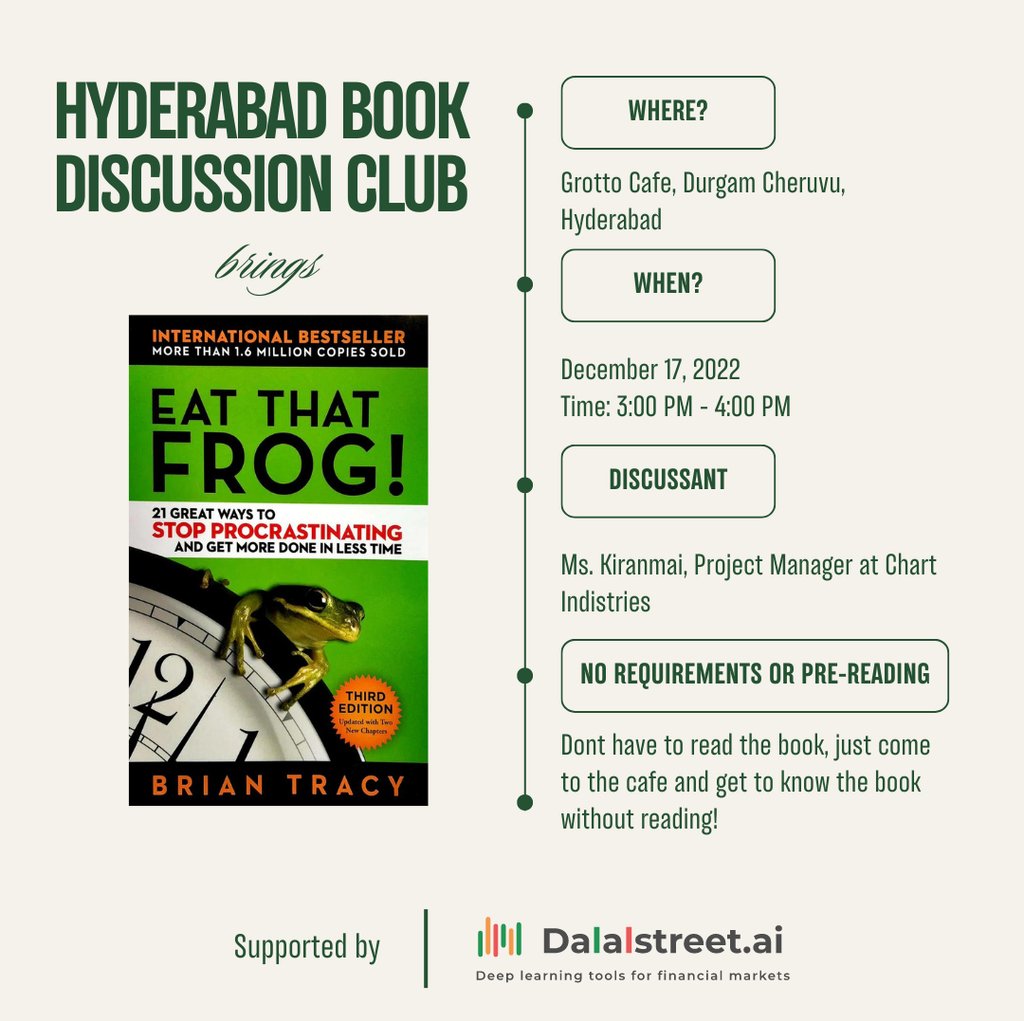Book: Eat that Frog
Author: Brian Tracy
BOOK DISCUSSIONS
12/17/20222 min read


Hyderabad Book Discussion Club
Book Title: Eat That Frog
Date: 17 December 2022
Acknowledgment
The Hyderabad Book Discussion Club thanks Dalalstreet.ai for their support and encouragement in conducting book discussions. The initiative recognises the importance of critically reading books, especially in an era where digital interactions often replace direct human communication. As a SAAS product company, Dalalstreet.ai’s encouragement of such community-led discussions is deeply appreciated.
1. Introduction
The discussant of the day, a project manager from Hyderabad with a passion for reading, travelling, and hiking, selected Eat That Frog based on personal experience. At a transitional stage in life, marked by significant changes in home, work, and environment, the book provided practical strategies for regaining focus and clarity. After implementing some of its recommendations with success, the discussant chose to share the book’s insights with the group.
2. Summary
The discussion began with the question: “What is something you postponed recently?”
Almost everyone could recall at least one task they had delayed and wished they hadn’t. This led into the introduction of Brian Tracy’s Eat That Frog, a book focused on sustaining productive habits. Known for authoring over 70 books, Tracy offers 21 strategies for habit formation and effective work management.
Key points covered include:
Plan ahead – Apply the 10-90 rule, where 10% of the time spent on planning can save 90% of execution time.
Use the 80/20 rule – Focus on the few tasks that generate the majority of results.
Consider consequences – Prioritise based on potential outcomes.
Practice creative procrastination – Intentionally delay low-value tasks.
Apply the ABCDE method – Categorise tasks from highest importance (“A”) to least important (“E”).
Focus on key result areas – Identify and prioritise essential outcomes.
Follow the law of three – Identify the three most critical tasks each day.
Prepare thoroughly before starting.
Take one step at a time.
Upgrade key skills – For example, learning through podcasts while commuting.
Identify and address constraints.
Create self-imposed deadlines.
Motivate yourself.
Use technology wisely – Avoid distractions; for example, turning off phones or deleting social media apps to reclaim time.
Focus attention – Avoid multitasking where possible, although rapid task-switching may be useful in some contexts.
Slice and dice tasks – Break large tasks into smaller, manageable steps.
Dedicate large chunks of time to important work.
Maintain a sense of urgency.
Single-handle tasks – Work on one task until completion.
3. Discussion
Participants noted that the book does not address situations where tasks of equal importance compete for attention—such as balancing family responsibilities with work commitments. The consensus was that tasks of equal priority can be grouped together in the same category, and that flexibility is important when priorities shift over time.
The group reflected on the book’s largely objective approach and agreed that while the principles are sound, applying them requires awareness of one’s personal and situational priorities, which are inherently subjective and may vary daily.
